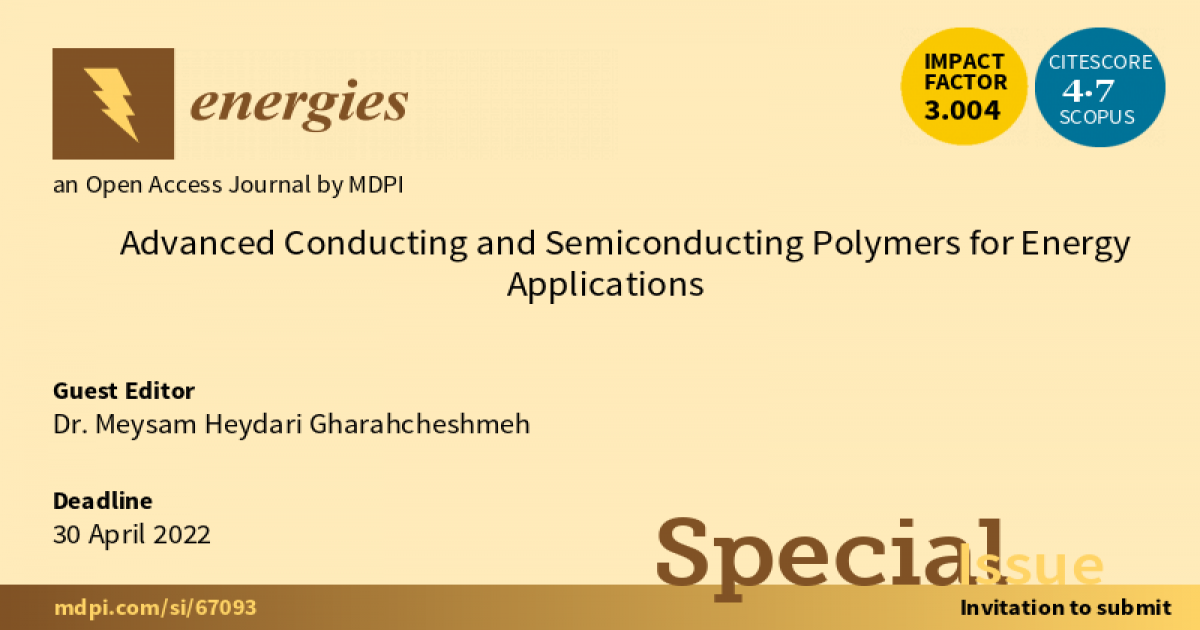- 3.2Impact Factor
- 7.3CiteScore
- 17 daysTime to First Decision
Advanced Conducting and Semiconducting Polymers for Energy Applications
This special issue belongs to the section “D1: Advanced Energy Materials“.
Special Issue Information
Dear Colleagues,
Conjugated conducting/semiconducting polymers have attracted an incredible amount of attention in energy and biocompatible device sectors. Electrical conductivity, ionic conductivity, optical transparency, biocompatibility, and mechanical flexibility are just a few of the many desirable characteristics of conjugated polymers. Due to these characteristics, conjugated conducting/semiconducting polymers reveal a promising performance in various technology applications, including photovoltaics, electrochemical energy storage devices, thermoelectric, flexible optoelectronic devices, biosensors, wearable electronics, and tissue engineering.
This Special Issue aims to collect original research and review articles on different classes of conjugated conducting/semiconducting polymers integrated into energy storage and harvesting devices. In addition to the applied point of view, the fundamental experimental and theoretical study of the electrical, ionic, and optoelectronic characteristics of conjugated polymers fabricated using different fabrication techniques, including solution-based, vapor phase deposition (VPP), oxidative chemical vapor deposition (oCVD), initiated chemical vapor deposition (iCVD), and so on, will be considered.
Dr. Meysam Heydari Gharahcheshmeh
Guest Editor
Manuscript Submission Information
Manuscripts should be submitted online at www.mdpi.com by registering and logging in to this website. Once you are registered, click here to go to the submission form. Manuscripts can be submitted until the deadline. All submissions that pass pre-check are peer-reviewed. Accepted papers will be published continuously in the journal (as soon as accepted) and will be listed together on the special issue website. Research articles, review articles as well as short communications are invited. For planned papers, a title and short abstract (about 250 words) can be sent to the Editorial Office for assessment.
Submitted manuscripts should not have been published previously, nor be under consideration for publication elsewhere (except conference proceedings papers). All manuscripts are thoroughly refereed through a single-blind peer-review process. A guide for authors and other relevant information for submission of manuscripts is available on the Instructions for Authors page. Energies is an international peer-reviewed open access semimonthly journal published by MDPI.
Please visit the Instructions for Authors page before submitting a manuscript. The Article Processing Charge (APC) for publication in this open access journal is 2600 CHF (Swiss Francs). Submitted papers should be well formatted and use good English. Authors may use MDPI's English editing service prior to publication or during author revisions.
Keywords
- conjugated polymers
- conducting polymers
- semiconducting polymers
- device integration
- flexible electronics
- biofunctional polymers
- nanostructural characterization

Benefits of Publishing in a Special Issue
- Ease of navigation: Grouping papers by topic helps scholars navigate broad scope journals more efficiently.
- Greater discoverability: Special Issues support the reach and impact of scientific research. Articles in Special Issues are more discoverable and cited more frequently.
- Expansion of research network: Special Issues facilitate connections among authors, fostering scientific collaborations.
- External promotion: Articles in Special Issues are often promoted through the journal's social media, increasing their visibility.
- e-Book format: Special Issues with more than 10 articles can be published as dedicated e-books, ensuring wide and rapid dissemination.

